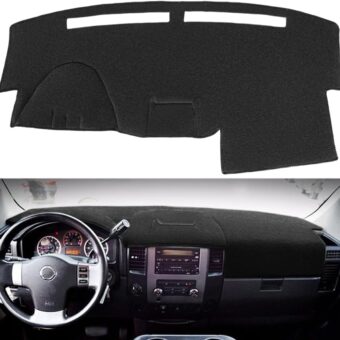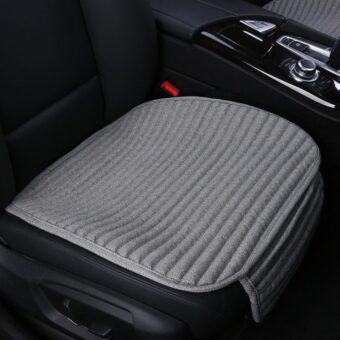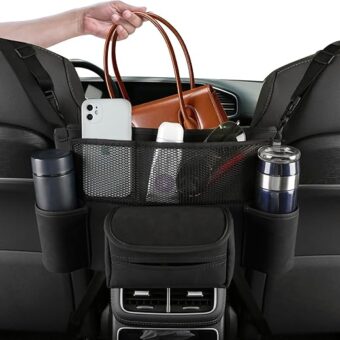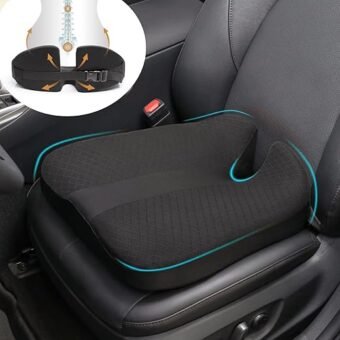When it comes to outfitting your vehicle, comfort is key, especially if you spend long hours behind the wheel. You might be wondering if neoprene seat covers are the right choice for you—after all, nobody wants to sit on a hot seat during those sweltering summer days. In this blog post, we’ll dive into the world of neoprene materials to understand how they handle heat and comfort. By the end, you’ll be equipped with the knowledge you need to make an informed decision that suits your lifestyle and keeps your ride enjoyable, no matter the climate. Let’s get started!
Understanding Neoprene Material
Neoprene, also known as polychloroprene, is a synthetic rubber that has gained significant popularity in various industries, particularly for its use in seat covers. Its unique combination of properties makes it a top choice for protecting your vehicle’s interior while providing comfort and durability. Let’s break down what neoprene is, its key properties, and why it stands out for automotive applications.
What is Neoprene?
Neoprene is a type of synthetic rubber that was invented in the 1930s. It is created through the polymerization of chloroprene, resulting in a versatile material that can withstand various environmental conditions. Neoprene is used extensively in diverse applications, such as wetsuits, computer sleeves, and of course, seat covers.
Common Uses of Neoprene:
- Wetsuits: Provides insulation and flexibility in water sports.
- Laptop Sleeves: Offers protection against scratches and impacts.
- Seat Covers: Shields against spills, dirt, and wear.
Key Properties of Neoprene
Waterproof Nature
One of the most remarkable properties of neoprene is its waterproof capability. This makes it ideal for seat covers, particularly for those who lead an active lifestyle or have kids and pets. Neoprene seat covers repel water, ensuring that any spills or moisture do not soak through and damage the upholstery beneath.
Durability
Neoprene is well-known for its strength and resilience. It can handle daily wear and tear, making it perfect for vehicles that see regular use. For example, the Covercraft NeoSupreme Seat Covers are made with durable neoprene fabric that boasts high resistance to scratches and abrasions. This durability ensures that your seat covers will last longer, retaining their aesthetic even after extensive use.
Flexibility
Another significant advantage of neoprene is its flexibility. This attribute allows neoprene seat covers to conform closely to the contours of your vehicle’s seats, providing a snug fit that enhances both comfort and style. Brands like Wet Okole design neoprene seat covers that hug your seats perfectly, offering a high level of comfort without compromising on protection.
Thermal Insulating Qualities
Neoprene is not just about functionality; it also provides excellent thermal insulation. This means that on hot days, the neoprene seat covers will not become unbearably hot, and in cooler weather, they help retain warmth. For example, many drivers who use DashMat’s Neoprene Seat Covers appreciate how these covers keep their seats at a more temperate level, boosting overall driving comfort.
Benefits of Neoprene Seat Covers
When considering seat covers, here are some key points that showcase why neoprene is a superior choice:
- Water Resistance: Keeps seats dry and protected from stains.
- Durability: Withstands everyday abrasions and impacts.
- Comfort: Provides a cozy feeling with its padding and insulation properties.
- Easy Maintenance: Most neoprene seat covers can simply be wiped down or hand-washed, making them practical and user-friendly.
- Custom Fit: Available in tailored fits for various makes and models, ensuring a sleek appearance.
| Feature | Neoprene Seat Covers | Other Materials |
|---|---|---|
| Waterproof | ✅ Yes | ❌ Usually Not |
| Durability | ✅ High | ❌ Varies (Lower) |
| Flexibility | ✅ Excellent | ❌ May Not Fit Well |
| Thermal Insulation | ✅ Yes | ❌ Limited |
| Maintenance | ✅ Easy to Clean | ❌ Often Harder to Clean |
Popular Neoprene Seat Cover Brands
If you’re convinced that neoprene seat covers are the way to go, consider checking out these reputable brands known for quality:
- Covercraft: Their NeoSupreme line combines style and functionality for a variety of vehicle types.
- Wet Okole: Custom-fit neoprene seat covers that offer extensive design options and top-notch protection.
- DashMat: Offers durable neoprene covers designed for maximizing comfort and aesthetic appeal.
By choosing neoprene seat covers, you’re making a wise decision to protect your vehicle’s interior against daily spills, dirt, and damage while enjoying enhanced comfort during your drives.
Heat Resistance of Neoprene
Neoprene, a synthetic rubber, is often lauded for its durability and flexibility, but its ability to resist heat is equally noteworthy. Understanding how neoprene behaves under various thermal conditions can help you make informed decisions regarding its use, whether in car seat covers, scuba gear, or other applications.
Resistance to Direct Sun Exposure
One of the primary catalysts for heat damage in materials is prolonged exposure to sunlight. Neoprene stands out in this regard because it is inherently UV-resistant, which helps maintain its integrity even when faced with direct sunlight.
Key Features of Neoprene Under Sunlight:
- UV Protection: Neoprene’s formulation includes UV inhibitors that help to shield the material from the sun’s harmful rays.
- Temperature Stability: Unlike some fabrics that may fade or weaken in sunlight, neoprene can withstand prolonged exposure without significant degradation.
Practical Examples:
- The Sierra Marine Neoprene Boat Seat Cover showcases neoprene’s durability. Designed for long-lasting outdoor use, it maintains its shape and color despite constant sun exposure, ensuring your boat looks sharp even in harsh conditions.
Vehicle Interior Temperatures
If you’ve ever entered a parked car on a hot summer day, you know how extreme vehicle interior temperatures can get. In such environments, the heat resistance of materials becomes essential for both comfort and longevity.
How Neoprene Performs in Cars:
- High Temperature Resistance: Neoprene can endure temperatures ranging from approximately -10°F to 175°F. This range makes it ideal for vehicle seat covers.
- Comfort in Heat: Neoprene does not absorb as much heat as leather or vinyl, making sitting in a neoprene seat cover more comfortable during hot weather.
Examples:
- Covercraft’s DashMat uses neoprene to protect dashboards from UV damage and high temperatures. This product helps maintain your vehicle’s interior aesthetics while contributing to overall comfort.
Comparison Table: Heat Resistance of Neoprene vs. Other Materials
| Material | Temperature Range (°F) | UV Resistance | Heat Absorption |
|---|---|---|---|
| Neoprene | -10 to 175 | High | Low |
| Leather | 0 to 120 | Medium | High |
| Vinyl | 0 to 140 | Low | Medium |
Body Heat Retention While Seated
While heat resistance is an advantage, the ability of neoprene to retain body heat can be a double-edged sword, particularly when it comes to sitting on neoprene seat covers for long durations.
Heat Retention Characteristics:
- Insulation Properties: Neoprene is an excellent insulator, meaning it traps heat. This can be beneficial in cooler weather but may become uncomfortable in hotter conditions.
- Breathability: Unlike leather or vinyl, which often traps heat, neoprene allows some airflow, thanks to its porous structure. This feature provides a balance between insulation and comfort.
Product Insights:
- Neoprene Car Seat Cushions, like those from Everlasting Comfort, help in preventing discomfort on hot days by providing a breathable surface, ensuring that body heat does not accumulate excessively.
Benefits of Neoprene in Various Settings
- Outdoor Sports: In locations where outdoor activities involve water, such as surfing or kayaking, products like O’Neill’s 3/2mm Psycho Tech wetsuit effectively manage body heat while insulating against cold water.
- Health and Safety: Neoprene is also used in medical braces (like Mueller’s Neoprene Knee Brace) where heat retention can help maintain warmth for injuries, promoting healing while providing necessary support.
Summary
Neoprene’s capacity to withstand high heat and retain body warmth makes it an exceptional material across numerous applications. From protecting vehicle interiors to enhancing comfort in active lifestyles and medical aids, its advantages are clear. By choosing quality neoprene products and understanding their properties, you can make decisions that improve both functionality and comfort.
Comfort Level of Neoprene Seat Covers
Neoprene seat covers are gaining popularity among car enthusiasts and everyday drivers alike for their unique blend of comfort and durability. In this section, we’ll delve into various aspects of comfort associated with neoprene seat covers—focusing on cushioning, fit, and breathability—and compare them to other common materials.
Cushioned Support
One of the standout features of neoprene seat covers is their cushioning. Neoprene, being a soft and flexible material, provides a comfortable padding that can significantly enhance the driving experience.
Benefits of Cushioning:
- Padded Comfort: Brands like Covercraft’s NeoSupreme Seat Covers offer excellent cushioning, making long drives feel more bearable.
- Impact Absorption: Neoprene does an excellent job absorbing shocks, reducing fatigue during bumpy rides or off-road adventures.
Consider how much time you spend in your vehicle. The added cushioning can transform a long commute into a more comfortable experience, ultimately affecting your overall enjoyment of time spent in your car.
Perfect Fit
The fit of seat covers can greatly influence comfort levels. Neoprene seat covers are designed to hug the contours of the seat, making them feel like an integral part of the vehicle rather than just an add-on.
Features of a Good Fit:
- Custom-Fit Options: Brands like Wet Okole offer custom-fit neoprene seat covers tailored to specific vehicle models, ensuring that every edge and curve is snug.
- Secure Attachment: Securely fitting seat covers reduce movement, which helps maintain comfort levels. Many neoprene covers come with fastening systems such as straps or hooks to keep them in place, minimizing sliding that might occur in less fitted models.
Breathability Matters
While neoprene is known for its water-resistant properties, breathability can sometimes be a concern. It’s essential to consider how various seat cover materials hold up in different climatic conditions.
Comparison of Breathability:
| Material | Breathability | Best for Climates | Examples |
|---|---|---|---|
| Neoprene | Moderate | Mild to Wet Climates | Covercraft NeoSupreme |
| Fabric | High | Hot and Dry Climates | FH Group Seat Covers |
| Leather | Low | Premium Comfort | Katzkin Leather Seats |
| Vinyl | Low | Moisture Resistance | BDK Vinyl Seat Covers |
Neoprene does not breathe as well as fabric, which might make it somewhat warm in hot environments. However, many neoprene covers, like those from Wet Okole, come with ventilation features designed to promote airflow, making them more comfortable during warm weather compared to traditional leather or vinyl options.
Climate Considerations
The climate you live in can play a significant role in how comfortable your seat covers will be. Let’s look at how neoprene and other materials stack up:
- Wet Environments: Neoprene excels in wet conditions thanks to its water-resistant properties—great for coastal areas where moisture can be a factor.
- Hot Climates: If you’re in a hot climate, breathable fabric might offer more comfort as it helps wick away moisture and keeps you cool.
- Cold Weather: Neoprene can feel warm and cozy during cold weather, making it ideal for places that experience chilly winters.
Personal Preference
Ultimately, individual comfort is subjective. While some drivers might love the plush feel of neoprene, others might prefer the breathability of fabric. Here are other seat cover options to consider based on different preferences:
- For Comfort Seekers: Neoprene by brands like Wet Okole offers excellent structure and snugness.
- For Heat Relief: Fabric covers from FH Group work well for those prioritizing ventilation in warmer climates.
- For Luxury Feel: Genuine leather from Katzkin gives a high-end look but may compromise on breathability.
Practical Examples
To solidify the points made, here are a few specific products to consider:
- Wet Okole Neoprene Seat Covers: Renowned for their custom fit and comfort; available in various colors and patterns to suit personal style.
- Covercraft NeoSupreme Seat Covers: Another fantastic option that offers a good blend of comfort, fit, and durability.
- FH Group Universal Seat Covers: Excellent choice for those in hot environments looking for breathable materials at an affordable price.
Incorporating neoprene seat covers into your vehicle can enhance comfort in various ways, making them a smart choice for many drivers.
Final Thoughts on Neoprene Comfort and Temperature Regulation
In conclusion, neoprene seat covers offer a unique blend of durability and comfort, but they can indeed retain heat, impacting your overall comfort level, especially in warmer climates. As we’ve explored, the material’s insulating properties may lead to a warmer sitting experience, particularly during hot summer days. Therefore, it’s essential to consider your personal circumstances, such as the climate you live in and how often you use your vehicle, before deciding if neoprene seat covers are the right choice for you. By weighing your comfort needs and environmental factors, you can make an informed decision that enhances your driving experience.









Great question! Wet Okole seat covers are designed with UV protection and are breathable, which helps keep you cooler. Many users report a noticeable difference in comfort during hot weather.
It’s definitely a debated topic! Neoprene has some heat-resistant properties, but factors like color, insulation, and ventilation of your vehicle can all play a role in how hot they feel. It’s great to hear different experiences!